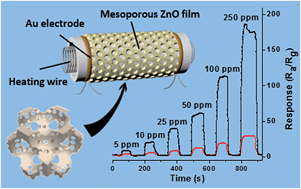Chelation-assisted soft-template synthesis of ordered mesoporous zinc oxides for low concentration gas sensing†
Abstract
Semiconductor zinc oxides with a high surface area and porosity offer great potential for their widespread applications, particularly in the areas of optoelectronic devices and solid-state gas sensors owing to their size-dependent physical and chemical properties. Herein, ordered mesoporous ZnO with uniform large mesopores and a crystalline framework is successfully synthesized through a citric acid assisted soft-template strategy using lab-made amphiphilic diblock copolymer poly(ethylene oxide)-b-polystyrene (PEO-b-PS) as a structure directing agent. A gradient calcination treatment is employed to transform the as-made zinc complex/template composites into hierarchically mesoporous crystalline zinc oxides via decomposition of copolymer templates and the intermediate of zinc carbonate, while preserving the highly ordered mesostructure. Owing to its well-connected bimodal mesopores, high surface area and crystalline ZnO framework, the obtained mesoporous ZnO exhibits excellent ethanol sensing performance with a fast response (6 s) and recovery (7 s), and high sensitivity and selectivity.


 Please wait while we load your content...
Please wait while we load your content...